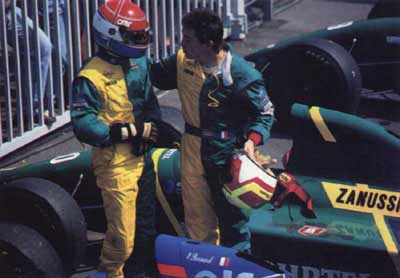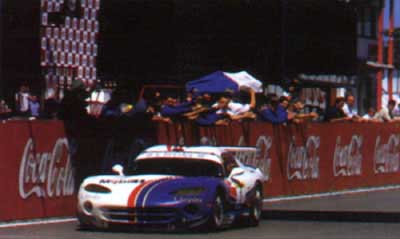| BEFORE FORMULA ONE | ||
|
Background
Born in the right place |
If your name and birthplace has anything to do with where you are headed in life, then
Olivier Beretta, born on 23 November, 1969 in Monaco, was destined for greatness as a racing driver.
Well, at least he became a racing driver, and if he has achieved any greatness, then it has been in 1999, five years after a failed attempt at F1. |
|
|
1989-91
Spends ages in F3 with few top results |
The first we hear of Beretta is in 1989, when he came 8th in the FIA Inter-nations Cup at Misano. The following year he collected one win in French F3 and came 3rd overall, as well as placing 3rd in the Monaco F3 race.
But, like many other F1 rejects, the longer he stayed in a category, the worse he did, Beretta dropping to 9th in French F3 in 1991, and 11th in British F3 in the same year. |
|
|
1992-93
Taken under the front wing of Piquet |
However, in 1992 Beretta was taken on by the legendary
Nelson Piquet
for his F3000 project, but the Piquet Racing Reynard failed to produce any top results.
Switching to Forti Corse in 1993, Beretta won the opening round of the F3000 championship at Donington from pole, before dropping back to finish 6th in the title chase. |
|
| FORMULA ONE | ||
|
|
||
|
1994 Larrousse Reasonably eventful season leaves Olivier with no real achievements |
Beretta's F3000 efforts, though, impressed Gerard Larrousse enough to be signed on for the Frenchman's F1 team in 1994, using a Cosworth V8 engine as team-mate to
Erik Comas. In his first outing in Brazil, he qualified a lowly 23rd out of 26, and then had the privilege of being involved in the first prang of the season, when he was clouted by
Bertrand Gachot's Pacific on lap three whilst trying to avoid
Eric Bernard's spinning Ligier.
At Aida, Beretta qualified 21st before suffering electrical problems in the race, while at the fateful San Marino GP he had an engine failure after starting 24th. On home soil around the streets of Monte Carlo, he put his car 20th on the grid, a spot behind J.J. Lehto's Benetton, and drove solidly to finish 8th. His improvement seemed to continue in Spain, where he qualified a career-best 17th, just behind Comas, only for his engine to fail on the opening lap. |
|
|
1994
Best result at Hockenheim demolition derby |
More engine failures followed in the next races in Canada and France, but he made it to the chequered flag again at Silverstone, where he came 14th, ahead of both Simteks. Nothing to write home about, though. His best result was to come at the next event in Germany, where he qualified 24th. When opening lap collisions and retirements took out some 11 cars, Beretta found himself running in tandem with Comas and gradually moving up the order as others fell by the wayside.
By race end, Gerhard Berger had won for Ferrari, with the Ligiers of Olivier Panis and Bernard 2nd and 3rd, the Footworks of Christian Fittipaldi and Gianni Morbidelli 4th and 5th, and the Larrousses 6th and 7th, Comas ahead. This 7th place finish would be the best in Beretta's career, and he can tell any future grandchildren that he finished ahead of Damon Hill. |
|
|
1994
No results. But more importantly - no money |
In Hungary, Beretta qualified 25th and once again ran close to Comas, eventually finishing 9th just behind his team-mate. But by this stage Larrousse were beginning to run short of cash, and Beretta was forced to give
way.
Philippe Alliot, fresh from a breif fill-in stint with McLaren, drove the car in Belgium, followed by Yannick Dalmas and Hideki Noda in the remaining rounds. Talent obviously wasn't as much of an issue as money. Not that they would have kept Beretta because of his talent... |
|
|
|
||
| AFTER FORMULA ONE | ||
|
1995-97
No luck at Le Mans, 3rd in GT2 class |
Like so many F1 rejects before and after him, Beretta has found his solace in sports car racing. He entered for Le Mans in 1995 in a Courage Chevrolet, but failed to qualify. When he did make the grid a year later in a Chrysler Viper GTSR with Philippe Gache and Eric Helary, he also made it to the finish in 21st spot.
In 1997 he joined the famous ORECA team to drive their Chrysler Vipers in the FIA GT championship, and this would prove to be a fruitful combination. Teamed with Gache that year, he came 3rd in the GT2 class, usually finishing just outside the top ten overall. With Dominique Dupuy and Tommy Archer, Beretta also came 15th in the Daytona 24hr race. |
|
|
1998-99
Consistency the key |
With Pedro
Lamy joining him as team-mate in 1998, Beretta became GT2 class champion, finishing all ten races between 6th and 9th in an astonishing show of consistency.
But at Le Mans, with Lamy and Archer, whilst coming 13th overall, this was only good enough for 2nd place in the GT2 class. |
|
|
1999
Olivier sweeps all before him in GT2 with Karl |
1999, though, has been Beretta's best year by far. New rules meant that GT2 class cars dominated the FIA GT championship, and now teamed up with
Karl Wendlinger in the ORECA Vipers, Beretta won 6 rounds to romp away as FIA GT champion.
In the American Le Mans Series, he became GTS class champ, taking 3 class wins with David Donohue, and other class victories with Wendlinger and Marc Duez. With Wendlinger and Dupuy, Beretta also won the GTS class at Le Mans. |
|
|
|
||
| back | ||



